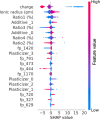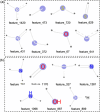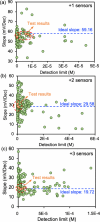Development of Machine Learning Models for Ion-Selective Electrode Cation Sensor Design
- PMID: 39021402
- PMCID: PMC11250033
- DOI: 10.1021/acsestengg.4c00087
Development of Machine Learning Models for Ion-Selective Electrode Cation Sensor Design
Abstract
Polyvinyl chloride (PVC) membrane-based ion-selective electrode (ISE) sensors are common tools for water assessments, but their development relies on time-consuming and costly experimental investigations. To address this challenge, this study combines machine learning (ML), Morgan fingerprint, and Bayesian optimization technologies with experimental results to develop high-performance PVC-based ISE cation sensors. By using 1745 data sets collected from 20 years of literature, appropriate ML models are trained to enable accurate prediction and a deep understanding of the relationship between ISE components and sensor performance (R 2 = 0.75). Rapid ionophore screening is achieved using the Morgan fingerprint based on atomic groups derived from ML model interpretation. Bayesian optimization is then applied to identify optimal combinations of ISE materials with the potential to deliver desirable ISE sensor performance. Na+, Mg2+, and Al3+ sensors fabricated from Bayesian optimization results exhibit excellent Nernst slopes with less than 8.2% deviation from the ideal value and superb detection limits at 10-7 M level based on experimental validation results. This approach can potentially transform sensor development into a more time-efficient, cost-effective, and rational design process, guided by ML-based techniques.
© 2024 The Authors. Published by American Chemical Society.
Conflict of interest statement
The authors declare no competing financial interest.
Figures




Similar articles
-
Revolutionizing Membrane Design Using Machine Learning-Bayesian Optimization.Environ Sci Technol. 2022 Feb 15;56(4):2572-2581. doi: 10.1021/acs.est.1c04373. Epub 2021 Dec 30. Environ Sci Technol. 2022. PMID: 34968041
-
Wearable Sweatband Sensor Platform Based on Gold Nanodendrite Array as Efficient Solid Contact of Ion-Selective Electrode.Anal Chem. 2017 Oct 3;89(19):10224-10231. doi: 10.1021/acs.analchem.7b01560. Epub 2017 Sep 22. Anal Chem. 2017. PMID: 28862001
-
All Solid-State Poly (Vinyl Chloride) Membrane Potentiometric Sensor Integrated with Nano-Beads Imprinted Polymers for Sensitive and Rapid Detection of Bispyribac Herbicide as Organic Pollutant.Molecules. 2019 Feb 16;24(4):712. doi: 10.3390/molecules24040712. Molecules. 2019. PMID: 30781449 Free PMC article.
-
Introduction to polymer-based solid-contact ion-selective electrodes-basic concepts, practical considerations, and current research topics.Anal Bioanal Chem. 2017 Jan;409(1):45-61. doi: 10.1007/s00216-016-9945-6. Epub 2016 Oct 1. Anal Bioanal Chem. 2017. PMID: 27695984 Review.
-
Developments in the Field of Conducting and Non-conducting Polymer Based Potentiometric Membrane Sensors for Ions Over the Past Decade.Sensors (Basel). 2008 Apr 3;8(4):2331-2412. doi: 10.3390/s8042331. Sensors (Basel). 2008. PMID: 27879825 Free PMC article. Review.
References
-
- Hu J.; Stein A.; Bühlmann P. Rational Design of All-Solid-State Ion-Selective Electrodes and Reference Electrodes. TrAC - Trends Anal. Chem. 2016, 76, 102–114. 10.1016/j.trac.2015.11.004. - DOI
-
- Huang Y.; Wang T.; Xu Z.; Hughes E.; Qian F.; Lee M.; Fan Y.; Lei Y.; Brückner C.; Li B. Real-Time in Situ Monitoring of Nitrogen Dynamics in Wastewater Treatment Processes Using Wireless, Solid-State, and Ion-Selective Membrane Sensors. Environ. Sci. Technol. 2019, 53 (6), 3140–3148. 10.1021/acs.est.8b05928. - DOI - PubMed
-
- Bakker E. Can Calibration-Free Sensors Be Realized?. ACS Sens. 2016, 1 (7), 838–841. 10.1021/acssensors.6b00247. - DOI
LinkOut - more resources
Full Text Sources
